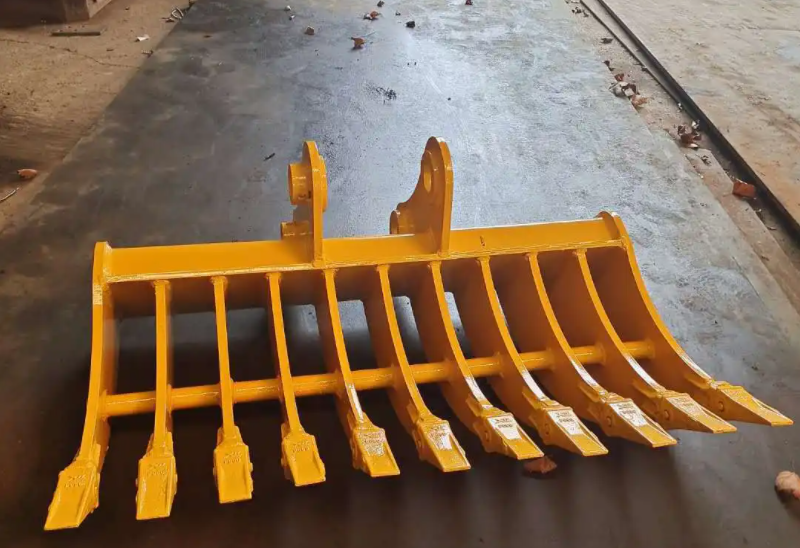Excavator rakes are essential equipment for any construction site. Unlike an excavator, you can use an excavator rake to perform precise tasks such as grading and leveling. The versatility of this equipment makes it one of the most commonly used components among contractors, and we believe that no construction should be done without the machine.

Before you choose, you should answer some questions. Which type is best for you? What specifications do I need? How much do I want to pay? If you’re looking for additional information on these topics, or just want to learn more about excavator rakes in general before you buy, read the complete guide below!
What does excavator rake mean?
Excavator rakes are used to loosen and remove topsoil, gravel or other materials from the ground. They can be mounted on the front of an excavator or tractor.
Rakes can have sharp steel teeth (cantilevers) to cut through roots and rock formations, or rubber fingers to loosen hard soil without damaging clods. The tool is very similar to a trencher, using a continuously rotating cutter head rather than multiple teeth.
Another common use for excavator harrows is scale tidying, where equipment such as harrows are used to move and tidy large amounts of land. Harrowing has several advantages over traditional tidying methods such as backhoes or excavators. For example, the process is relatively quiet, dust-free, and has minimal impact on traffic flow or pedestrians.
Why rake with an excavator?
The main advantage of excavator harrowing is that you can control it quickly. Rakes can be moved in any direction, making them ideal for cleaning up the environment and for general grading. They excel at removing loose soil from roads or other hard surfaces without damaging asphalt and concrete infrastructure. The raised teeth also ventilate the soil, making it easier for plants to grow.
Barra minn hekk, the flexibility of an excavator rake means it was previously impossible to do it neatly. Rather than razing the entire area where you want to work, this saves money and time and reduces the consumption caused by leftover soil.
Types of excavator rakes available
There are many different kinds of excavator rakes. Some rakes may be better suited to your construction site than others, so it’s important to have a good idea of how each one works before deciding which one to purchase.
Excavator Rakes – Excavator rakes have very large and sharp teeth so you can use them to tidy up hard-driven soil. These are ideal for concrete or gravel driveways, foundations and other areas where surface materials must be tidied.
Land Leveling Rakes – These rakes feature a set of tines that can handle medium-sized rock formations and are very reasonably priced. The barge in front of the rake is used to accurately, neaten and level the soil. This type of rake works well around communities or road separations.
Multi-Tooth Rakes – These rakes have longer teeth than flat rakes. As a result, the teeth can handle larger rock formations without affecting the soil during the tidying process. You should use these rakes for layout and design of subdivisions, streets and parking lots.
Drain Cleaning Rakes – Drain cleaning rakes have very sharp teeth with some perspective and can cut through hardpan material like butter. You can use them to clean drains.
Compartment scraper rake – These rakes are used to scrape off large areas of soil and gravel. They are usually equipped with multiple cutter heads or shovels at the end to tidy up large areas faster than excavator rakes.
Blade Scraper Rakes – These rakes feature a set of rotating cutter heads that you can use to remove asphalt, hardpan soil, and even some concrete. They can be mounted on the front and back of an excavator or tractor to increase the efficiency of flat work. These devices are commonly used on construction sites in paving businesses.
Safety precautions when using excavator rakes
Because excavator rakes are more aggressive than traditional tidy equipment, they should be used with care.
Do not attempt to explore soil that is too wet or too hard, as it could damage the rake’s teeth and prevent it from working properly. Always check the manufacturer’s specifications to confirm the proposed material limitations to ensure that the rake is replaced before then.
Carefully address manure, wood residue or other organic materials. In this case, the rake is likely to clog quickly. If necessary, use a vegetable lubricant to maintain successful operation.
Check your hydraulic hose to make sure it is secure enough at all times. If they are loose, engine power will be directed to your hydraulic equipment, which could seriously affect other components (such as cylinders and pumps).
If you want to use a backhoe rake modified backhoe in a backhoe forklift, make sure you install the proper brackets to prevent it from flying off the back end and hitting anything.
Final thoughts If you need a neat, large area of soil, but don’t want to buy more expensive equipment, an excavator rake is a good choice. Using a small excavator that can’t carry heavy machinery is also helpful.
As long as you exercise carefully, from long to short, and avoid working in wet conditions or on land that is too hard, you should be able to use your excavator rake for years without any problems.
 Attachments tal-Barmil tal-Excavator – Fabbrikant Auger tad-Dinja OEM & ODM
Attachments tal-Barmil tal-Excavator – Fabbrikant Auger tad-Dinja OEM & ODM